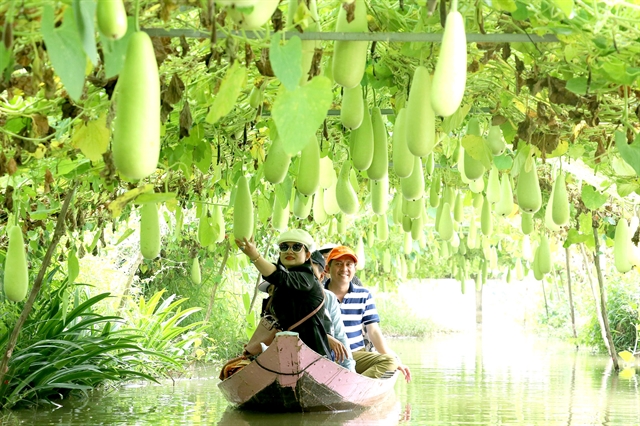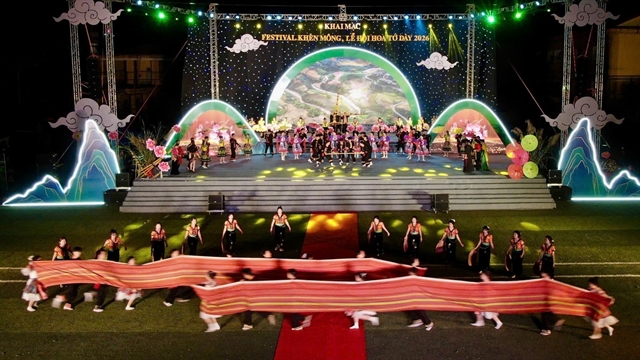.jpg) Economy
Economy

 |
| Tourists visit a farm tourist area in Đồng Tháp Province. Việt Nam has potential and strengths in rural tourism development in three forms: community tourism, agro-tourism and ecotourism. VNA/VNS Photo |
HÀ NỘI — Experts consider rural areas a 'gold mine' for the tourism industry to diversify products, and there is a lot of work to be done.
Statistics from the World Tourism Organisation (UNWTO) show that the number of tourists participating in rural and ecological forms of tourism accounts for about 10 per cent, with revenue of approximately US$30 billion per year. On average, each year, the proportion of rural tourists increases by 10-30 per cent.
In Việt Nam, rural destinations had received considerable attention, especially after the tourism industry opened its doors to international visitors after the pandemic, said the chairman of the Vietnam Tourism Association Vũ Thế Bình.
With nearly 65.6 per cent of the population living in rural areas with beautiful landscapes and preserving many cultural and historical values, Việt Nam has potential and strengths in rural tourism development in three forms: community tourism, agro-tourism and ecotourism, according to the chairman.
Chairman of the Tourism Advisory Council Trần Trọng Kiên said that the rural tourism model had not only brought livelihoods to farmers but also contributed to preserving and promoting traditional cultural values and ecological landscape, all while supporting the diverse and sustainable development of tourism destinations.
According to information from the Vietnam National Administration of Tourism, the country currently has 365 rural tourist destinations in 37 provinces and cities and more than 2,000 traditional craft villages with potential for further development. In many localities, rural tourism is spearheading economic development.
The administration said Hà Nội alone has 806 craft villages that run as rural tourism models, including Ba Vì, Quốc Oai, Gia Lâm, Sơn Tây, Mỹ Đức and Thường Tín districts.
For example, Đồng Quê farm in Ba Vì District is a destination for tourists and students of international for extracurricular activities, in which they can experience an old Vietnamese village space and try growing vegetables and harvesting agricultural products.
In Thường Tín, Nguyễn Văn Tú, the director of Hồng Vân Flower, Ornamental and Service Cooperative, said visitors could experience agricultural tourism in the commune by collecting seasonal agricultural products, visiting the production, processing and packaging area of herbal teas.
Despite the potential, rural tourism still has many shortcomings, according to experts.
Chairman of the Vietnam Community Tourism Association, Phạm Hải Quỳnh, said that the drawback of rural tourism was the lack of synchronous infrastructure and quality accommodation facilities to keep guests staying longer.
He added: "Rural tourism has developed fragmented and spontaneously, mainly small business households, due to the lack of planning, mechanisms and policies to support the development of this field."
"The subjects of rural tourism development are local households, so the investment potential is limited and could not create an overall tourism picture. However, rural people desperately need support to complete infrastructure and improve the environment," he said.
Chairman of Hà Nội Travel Association, Phùng Quang Thắng, said that rural tourism products were still poor while the labour force, who were mostly local people, had weak knowledge and skills to perform tourism services.
Deputy Director of Hà Nội Department of Tourism Trần Trung Hiếu added that the number and scale of agricultural tourism enterprises were limited, and the system of supporting infrastructure for agricultural tourism was not synchronous, making it difficult for tourists to access this type of tourism.
Tourism experts said the locality needed to plan and invest in rural tourism to overcome these inadequacies. Inviting experts to build attractive and unique tourism products that achieve high efficiency was necessary.
Chairman of the Việt Nam Tourism Association Vũ Thế Bình pointed out that developing rural tourism required localities to have specific regulations and appropriate policies on the conversion of agricultural land use for tourism development.
Currently, Hà Nội city focuses on piloting six models of agricultural and rural tourism development; community-based tourism; smart tourism village; craft village tourism in the direction of green, responsible and sustainable tourism in the districts of Thường Tín, Đan Phượng, Thanh Trì, Mỹ Đức, Thạch Thất and Sơn Tây town. — VNS

.jpg)


